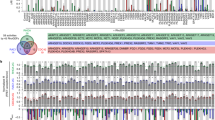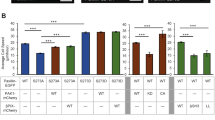Abstract
Adherens junctions (AJs) are crucial for maintaining the integrity of epithelial tissues and are often disrupted during tumour progression. Rho family proteins have been shown to regulate adherens junctions. We find that activation of the effector kinase ROCK and acto-myosin contraction disrupts AJs downstream of Rho. In contrast, signalling through the Rho effector Dia1 is required to ensure a dynamically stable interface between cells and the maintenance of adherens junction complexes. The ability of Dia1 to regulate the actin network is crucial for the localization of adherens junction components to the cell periphery.
This is a preview of subscription content, access via your institution
Access options
Subscribe to this journal
Receive 12 print issues and online access
$209.00 per year
only $17.42 per issue
Buy this article
- Purchase on Springer Link
- Instant access to full article PDF
Prices may be subject to local taxes which are calculated during checkout







Similar content being viewed by others
References
Yap, A. S., Brieher, W. M. & Gumbiner, B. M. Molecular and functional analysis of cadherin-based adherens junctions. Annu. Rev. Cell Dev. Biol. 13, 119–146 (1997).
Fukata, M. & Kaibuchi, K. Rho-family GTPases in cadherin-mediated cell–cell adhesion. Nature Rev. Mol. Cell Biol. 2, 887–897 (2001).
Van Aelst, L. & D'Souza-Schorey, C. Rho GTPases and signaling networks. Genes Dev. 11, 2295–2322 (1997).
Ridley, A. J. Rho GTPases and cell migration. J. Cell Sci. 114, 2713–2722 (2001).
Braga, V. M., Machesky, L. M., Hall, A. & Hotchin, N. A. The small GTPases Rho and Rac are required for the establishment of cadherin-dependent cell–cell contacts. J. Cell Biol. 137, 1421–1431 (1997).
Takaishi, K., Sasaki, T., Kotani, H., Nishioka, H. & Takai, Y. Regulation of cell–cell adhesion by rac and rho small G proteins in MDCK cells. J. Cell Biol. 139, 1047–1059 (1997).
Jou, T. S. & Nelson, W. J. Effects of regulated expression of mutant RhoA and Rac1 small GTPases on the development of epithelial (MDCK) cell polarity. J. Cell Biol. 142, 85–100 (1998).
Bishop, A. L. & Hall, A. Rho GTPases and their effector proteins. Biochem. J. 348, 241–255 (2000).
Kimura, K. et al. Regulation of myosin phosphatase by Rho and Rho-associated kinase (Rho-kinase). Science 273, 245–248 (1996).
Maekawa, M. et al. Signaling from Rho to the actin cytoskeleton through protein kinases ROCK and LIM-kinase. Science 285, 895–898 (1999).
Vincent, S. & Settleman, J. The PRK2 kinase is a potential effector target of both Rho and Rac GTPases and regulates actin cytoskeletal organization. Mol. Cell. Biol. 17, 2247–2256 (1997).
Watanabe, N. et al. p140mDia, a mammalian homolog of Drosophila diaphanous, is a target protein for Rho small GTPase and is a ligand for profilin. EMBO J. 16, 3044–3056 (1997).
Alberts, A. S. Identification of a carboxyl-terminal diaphanous-related formin homology protein autoregulatory domain. J. Biol. Chem. 276, 2824–2830 (2001).
Ishizaki, T. et al. Coordination of microtubules and the actin cytoskeleton by the Rho effector mDia1. Nature Cell Biol. 3, 8–14 (2001).
Palazzo, A. F., Cook, T. A., Alberts, A. S. & Gundersen, G. G. mDia mediates Rho-regulated formation and orientation of stable microtubules. Nature Cell Biol. 3, 723–729 (2001).
Bhowmick, N. A. et al. Transforming Growth Factor-β1 Mediates Epithelial to Mesenchymal Transdifferentiation through a RhoA-dependent Mechanism. Mol. Biol. Cell 12, 27–36 (2001).
Wojciak-Stothard, B., Potempa, S., Eichholtz, T. & Ridley, A. J. Rho and Rac but not Cdc42 regulate endothelial cell permeability. J. Cell Sci. 114, 1343–1355 (2001).
Calautti, E. et al. Fyn tyrosine kinase is a downstream mediator of Rho/PRK2 function in keratinocyte cell–cell adhesion. J. Cell Biol. 156, 137–148 (2002).
Hiscox, S. & Jiang, W. G. Expression of E-cadherin, α, β and γ-catenin in human colorectal cancer. Anticancer Res. 17, 1349–1354 (1997).
Sahai, E. & Marshall, C. J. RhoGTPases and Cancer. Nature Reviews Cancer 2, 133–142 (2002).
Gayet, J. et al. Extensive characterization of genetic alterations in a series of human colorectal cancer cell lines. Oncogene 20, 5025–5032 (2001).
Fukata, M. et al. Involvement of IQGAP1, an effector of Rac1 and Cdc42 GTPases, in cell–cell dissociation during cell scattering. Mol. Cell Biol. 21, 2165–2183 (2001).
Sahai, E., Alberts, A. S. & Treisman, R. RhoA effector mutants reveal distinct effector pathways for cytoskeletal reorganization, SRF activation and transformation. EMBO J. 17, 1350–1361 (1998).
Davies, S. P., Reddy, H., Caivano, M. & Cohen, P. Specificity and mechanism of action of some commonly used protein kinase inhibitors. Biochem J. 351, 95–105 (2000).
Sahai, E., Olson, M. F. & Marshall, C. J. Cross-talk between Ras and Rho signalling pathways in transformation favours proliferation and increased motility. EMBO J. 20, 755–766 (2001).
Noren, N. K., Niessen, C. M., Gumbiner, B. M. & Burridge, K. Cadherin engagement regulates Rho family GTPases. J. Biol. Chem. 276, 33305–33308 (2001).
Quinlan, M. P. & Hyatt, J. L. Establishment of the circumferential actin filament network is a prerequisite for localization of the cadherin–catenin complex in epithelial cells. Cell Growth Differ. 10, 839–854 (1999).
Vasioukhin, V., Bauer, C., Yin, M. & Fuchs, E. Directed actin polymerization is the driving force for epithelial cell–cell adhesion. Cell 100, 209–219 (2000).
Quinlan, M. P. Rac regulates the stability of the adherens junction and its components, thus affecting epithelial cell differentiation and transformation. Oncogene 18, 6434–6442 (1999).
Tokman, M. G., Porter, R. A. & Williams, C. L. Regulation of cadherin-mediated adhesion by the small GTP-binding protein Rho in small cell lung carcinoma cells. Cancer Res. 57, 1785–1793 (1997).
Hill, C. S., Wynne, J. & Treisman, R. The Rho family GTPases RhoA, Rac1, and CDC42Hs regulate transcriptional activation by SRF. Cell 81, 1159–1170 (1995).
Tominaga, T. et al. Diaphanous-related formins bridge Rho GTPase and Src tyrosine kinase signaling. Mol. Cell 5, 13–25 (2000).
Ishizaki, T. et al. p160ROCK, a Rho-associated coiled-coil forming protein kinase, works downstream of Rho and induces focal adhesions. FEBS Lett. 404, 118–124 (1997).
Acknowledgements
E.S. and C.J.M. are funded by Cancer Research UK; C.J.M. is a Gibb Life Fellow of Cancer Research UK. We thank M. Fukata for GFP–α-catenin, A. Alberts for GFP–mDia1ΔN, H. Paterson for help with microscopy, D. Croft and M. Olson for comments on the manuscript.
Author information
Authors and Affiliations
Corresponding author
Supplementary information
Supplementary figure
Figure S1. Effects of Dia mutants on actin and microtubule networks a, HCT116 cells in 1% DCS were injected with expression constructs for GFP-mDia1ΔN, GFPmDia1ΔNK>A or mDia1ΔNΔC. 16 hours after injection the cells were fixed and stained for GFP or myc-epitope to detect exogenous Dia expression, β-tubulin, and F-actin. b, HEK 293 cells were transfected with either mDia1ΔNΔC, RhoAV14 or mDia1ΔNΔC and RhoAV14, 24 hours after transfection cells were fixed and stained for myc-epitope to detect transfected cells and F-actin. (PDF 153 kb)
Supplemetary movie
Movie 1. HCT116 cells in 10% DCS expressing GFP-α-catenin, frames are 60 seconds apart. (AVI 1280 kb)
Supplemetary movie
Movie 2. HCT116 cells in 10% DCS expressing GFP-α-catenin and C3, frames are 60 seconds apart. (AVI 3784 kb)
Supplemetary movie
Movie 3. HCT15 cells in 10% DCS expressing GFP-α-catenin, frames are 60 seconds apart. (AVI 800 kb)
Supplemetary movie
Movie 4. HCT15 cells in 10% DCS expressing GFP-α-catenin and mDia1ΔNΔC, frames are 60 seconds apart. (AVI 2868 kb)
Rights and permissions
About this article
Cite this article
Sahai, E., Marshall, C. ROCK and Dia have opposing effects on adherens junctions downstream of Rho. Nat Cell Biol 4, 408–415 (2002). https://doi.org/10.1038/ncb796
Received:
Revised:
Accepted:
Published:
Issue Date:
DOI: https://doi.org/10.1038/ncb796
This article is cited by
-
The pseudoenzyme ADPRHL1 affects cardiac function by regulating the ROCK pathway
Stem Cell Research & Therapy (2023)
-
Role of RhoC in cancer cell migration
Cancer Cell International (2021)
-
The RhoA dependent anti-metastatic function of RKIP in breast cancer
Scientific Reports (2021)
-
The integrity of cochlear hair cells is established and maintained through the localization of Dia1 at apical junctional complexes and stereocilia
Cell Death & Disease (2020)
-
User-defined morphogen patterning for directing human cell fate stratification
Scientific Reports (2019)



